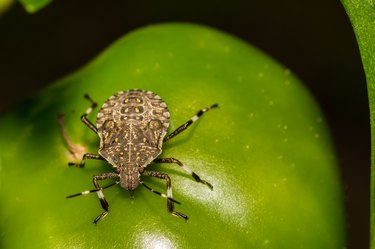
Aphids and lace bugs are common plant bugs that lay dark-colored eggs on the leaves of many plants. The eggs typically overwinter on the leaves, and they hatch in the spring. Determining what kind of insect egg you are dealing with is the first step toward treating affected plants. In some cases, treatment may not be necessary if the plant is not experiencing significant damage.
Aphid Eggs on Leaves
Video of the Day
A number of species of aphids – common plant bugs that survive by extracting moisture from leaves – overwinter as shiny, dark eggs on the foliage of many types of trees and plants. Most aphid species specialize on one or a small group of plants. Examples of aphids that lay black eggs include the black cherry aphid, which primarily targets cherry trees.
Video of the Day
If you spot black insect eggs on rose leaves, they are probably potato aphid eggs. This species lays its eggs exclusively on wild and ornamental roses. The eggs of the green peach aphid start off yellow or green and eventually turn black. This species lays its eggs on stone fruit trees, like peach, nectarine and plum trees. Aphids usually mate and lay eggs in the fall. The eggs hatch in the spring.
Lace Bug Eggs on Leaves
If you notice black insect eggs on the underside of leaves that appear to be partially inserted into the leaf tissue, they might be lace bug eggs. Lace bugs are tiny, winged insects that suck sap from the leaves of ornamental plants and trees, causing discoloration. Very rarely does a lace bug infestation harm a plant's health, however.
There are approximately 140 lace bug species in North America. They include the azalea lace bug, which affects azaleas specifically. Another species infests lantanas. Some lace bugs also attack trees. Oak, elm and pyracantha are some of the tree species that are often affected by lace bugs.
While lace bug eggs are actually pale in color, many species secrete a dark substance over the eggs. This substance helps the eggs to stick to the leaves, and it gives them a black appearance.
Eliminating Black Insect Eggs
Treatment for black eggs on leaves depends on the type of insect involved. On ornamental plants, you can use insecticidal soaps to eliminate aphid eggs. To eliminate aphid eggs that have overwintered on trees, you can apply horticultural oil as a delayed dormant treatment in late winter or as a spray. This involves spraying the trees with oil once the buds have swelled but before they begin to open and before leaves emerge.
However, insecticidal soaps and horticultural oils have no effect on lace bug eggs, in part because they are well-protected by their dark coating. For this reason, it is best to treat lace bugs as nymphs soon after they hatch. Avoid using harsh pesticides against lace bugs, however, as these chemicals can kill the beneficial insects that prey on lace bugs and keep their populations under control. In many cases, lace bug infestations are not severe enough to require treatment.
- University of Maryland Extension: Lace Bugs on Trees and Shrubs
- Missouri Botanical Garden: Lace bugs
- Utah State University Extension: Black Cherry Aphid
- Utah State University Extension: Aphids
- University of Nevada, Reno Extension: Aphids and Their Management in Home Gardens
- NC State University Extension: Azalea Lace Bug
- University of Maryland Extension: Aphids on Trees and Shrubs